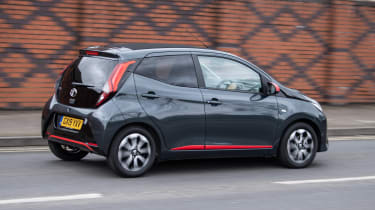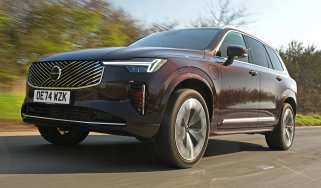Toyota Aygo hatchback review (2014-2022)
"The Toyota Aygo has a bold design, thrifty engine and comes in a varied mix of trims"
Pros
- Very economical
- Agile handling
- Stylish looks
Cons
- Outdone by some rivals
- Limited boot and rear-seat space
- Basic interior on low-spec models
The second-generation Toyota Aygo has a distinctive, angular design, set apart further by the large ‘X’ on its nose. A mid-life facelift in 2018 gave the Aygo an even sharper appearance, thanks to new LED lights and bumpers. The result was an Aygo more in keeping with Toyota’s latest family look, while extra equipment was added too. In 2022, the Aygo was replaced with the Toyota Aygo X, which has all the strengths of the small city car, but with an SUV-style design.
Facelift aside, this is the second-generation Aygo that replaced the original in 2014. It has a more spacious cabin than its predecessor, thanks in part to being a little bigger on the outside. In spite of the small but noticeable growth spurt, the car remains Toyota’s smallest model and running costs will be very low as a result. The Aygo line-up was slimmed down to four models in 2020, and there’s only a five-door body available, which is usual in the city car class these days. Talking of which, the Aygo has some competent and appealing rivals including the Kia Picanto and Hyundai i10, as well the Peugeot 108 and Citroen C1 that are built alongside the Aygo at a joint venture factory in the Czech Republic.
More reviews
The Aygo may look quite different to the Citroen C1 and Peugeot 108, but underneath their individual designs they share the same engineering, including the 71bhp 1.0-litre petrol engine. We think most would agree the Aygo is more stylish than its stablemates, and it also has a longer warranty than its French cousins. Although the range starts from just under £13,500, go for the top x-clusiv trim and you’ll pay closer to £16,000. We’d recommend buying an Aygo from the lower end of the range, as prices for the more expensive models are knocking on the door of the next class up.
As well as having just the one engine, the majority of Aygos are ordered with the standard five-speed manual gearbox, and it’s the better choice unless you really need an auto.
The x-shift automatic is ponderous and not particularly smooth, and it slows the car down too. The 0-62mph time of 15.2 seconds compares to 13.8 in the manual. Economy also suffers, albeit slightly, worsening to 54.3mpg from 56.5mpg. All Aygos cost the standard rate per year to tax.
With a car like the Aygo, you wouldn’t expect too much to go wrong, but it’s good to know Toyota now provides a warranty lasting up to 10 years/100,000 miles, so long as you service the car at a franchised service centre. There’s also a 12-year anti-corrosion warranty that can be passed to the next owner. The Aygo finished 43rd out of the 75 cars ranked in our 2018 Driver Power owner satisfaction survey of cars currently on sale in the UK. Not enough owners took the survey in 2020 but Toyota finished a reassuring sixth out of 30 manufacturers.
Independent crash-testing body Euro NCAP awarded the Aygo four out of five stars in 2014. Electronic stability control, seatbelt reminders for the front and rear seats and ISOFIX child-seat mounting points for the outer two rear seats are fitted as standard. From summer 2020, the Toyota Safety Sense suite of safety kit was also included as standard.

















